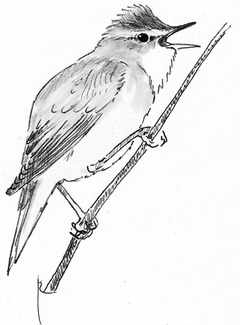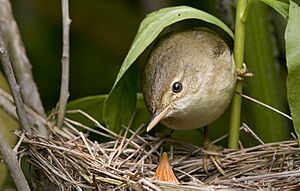Marsh warbler facts for kids
Quick facts for kids Marsh warbler |
|
|---|---|
 |
|
| In Poland | |
| Conservation status | |
| Scientific classification | |
| Genus: |
Acrocephalus (bird)
|
| Species: |
palustris
|
 |
|
| Breeding
Passage Nonbreeding |
|
The marsh warbler (Acrocephalus palustris) is a small bird that belongs to a group called Old World warblers. It lives and raises its young in cool parts of Europe and western Asia. When winter comes, it flies all the way to southern Africa.
This bird is famous for its amazing song. Male marsh warblers can copy the sounds of many other birds! They often live in damp, wet places when they are breeding. But in Africa, they prefer dry areas with lots of plants.
Marsh warblers are quite common in many places where they breed. In some areas, their numbers are even growing. However, in Britain, they have almost disappeared as breeding birds. Scientists are not sure why this is happening. This warbler mainly eats insects. It can look very similar to other warblers, but its special song helps tell it apart.
Contents
Understanding the Marsh Warbler's Name
Every living thing has a scientific name, like a secret code. This helps scientists around the world know exactly which plant or animal they are talking about. The marsh warbler's scientific name is Acrocephalus palustris.
A German scientist named Johann Matthäus Bechstein first described this bird in 1798. He gave it the name Motacilla s. Sylvia palustris. Later, it was moved to the group (genus) called Acrocephalus. This group was created by Johann Andreas Naumann and his son Johann Friedrich Naumann in 1811.
The name Acrocephalus comes from old Greek words. Akros means "highest" and kephale means "head". The second part of the name, palustris, is Latin for "marshy". This fits the bird well because it often lives in marshy areas. All marsh warblers around the world are considered to be the same type, with no big differences based on where they live.
What Does a Marsh Warbler Look Like?
The marsh warbler is a medium-sized warbler. It looks very similar to other warblers in its group, like the reed warbler. Reed warblers also live in wet places and in similar parts of the world.
It can be tricky to tell marsh warblers apart just by looking at them. Both male and female marsh warblers look the same. The best way to identify a marsh warbler is by listening to the male's unique song. No other warbler in this group copies other birds as much as the marsh warbler does. Also, marsh warblers usually avoid areas with only tall reeds, which reed warblers love.
Sometimes, marsh warblers have even been known to breed with reed warblers or Blyth's reed warblers, creating mixed-species young.
The Marsh Warbler's Amazing Song
The marsh warbler is most famous for its incredible song. Male marsh warblers sing a lot, and sometimes females sing a simple song too. Each male marsh warbler learns to copy the calls and songs of many different birds.
They often imitate other small songbirds. But they can also copy sounds from birds like waders (shorebirds), hornbills (birds with big beaks), and pigeons. On average, each male marsh warbler can imitate about 75 different bird species! They tend to copy more African birds than European ones.
Marsh warblers learn all their songs when they are young. They learn sounds during their first summer in Europe or Asia, and during their first winter in Africa. They don't add new sounds to their song after their first year. Besides their special song, they also make other simple calls.
Where Do Marsh Warblers Live?
Marsh warblers breed in the middle parts of Europe and western Asia. This area stretches from the English Channel all the way to about 70 degrees east. They mostly live in places with a continental climate, which means hot summers and cold winters. However, they also used to breed in Britain and northern France.
These birds usually live in low-lying areas. But in Georgia, they can be found in mountains up to 3000 meters high. In recent years, they have been spreading north. More marsh warblers are now breeding in Scandinavia and north-west Russia. Sometimes, singing males are even heard in Ireland.
Marsh Warbler Habitats
In western Europe, marsh warblers mostly breed in thick, wild plants growing on damp or wet ground. They especially like tall plants like nettles, meadowsweet, willowherbs, and young willow trees. They can even breed in city areas that have suitable plants, like in Berlin. Sometimes, they are found in farm fields too.
In the eastern parts of their range, they also breed on dry hillsides with shrubs and in open woodlands. They use these places in addition to the wetter habitats they prefer in the west.
Their Long Journey: Migration
Marsh warblers spend their winters mainly in south-east Africa. This area goes from Cape Province north to Zambia and Malawi. In Africa, they live in various places with lots of plants, from moist bushes to thick forests. They can be found at altitudes up to 2400 meters.
These birds usually migrate from Europe to Africa by flying over the Middle East. Many cross Arabia and arrive in Africa on Sudan's Red Sea coast. Adult birds usually leave their breeding grounds soon after their young can fly on their own. The young birds follow about two weeks later.
On the Red Sea coast, most birds arrive between mid-August and mid-September. Adult numbers are highest in August, and young birds peak in September. Birds often spend the autumn in north-east or east Africa. Then, they continue south, arriving at their winter homes in December or January.
In spring, marsh warblers leave Africa in March or April. They are thought to fly back along similar routes. Birds breeding in south-east Europe might arrive by late April. In other areas, most birds don't arrive until mid-May. In places like England, on the western edge of their range, birds usually don't arrive until late May or early June.
Sometimes, a marsh warbler might fly far off course. These lost birds, called vagrants, have been seen as far away as Iceland and Madeira.
Marsh Warbler Behaviour and Life Cycle
Reproduction and Nesting
Marsh warblers usually have one mate at a time. They often choose a new mate each year. They also don't always return to the exact same place to breed each spring.
When they are breeding, they set up and defend their own areas, called territories. These territories are often grouped together in loose colonies. In Africa, during winter, they mostly live alone and might also defend a small area.
The nest is shaped like a cup. It is made mostly from leaves and plant stems. The nest is usually hidden in thick plants, at different heights from the ground. The female lays three to six eggs. Both the male and female marsh warblers help feed the baby birds in the nest. In Europe, their breeding season is quite short, lasting about 52 to 55 days.
In some places, like Bulgaria, marsh warblers face a challenge. Common cuckoos sometimes lay their eggs in marsh warbler nests. This is called brood parasitism. The cuckoo chick then gets raised by the marsh warbler parents.
What Do Marsh Warblers Eat?
The marsh warbler mainly eats insects. They also eat some spiders and a few small snails. They usually find insects by picking them off plants. Sometimes, they catch insects on the ground or even in the air. In autumn, they might eat a small number of berries.
Scientists haven't studied their diet in Africa in great detail. However, they know that the way marsh warblers find food in winter is very similar to how they do it in other seasons.
Protecting the Marsh Warbler
Globally, the number of marsh warblers is believed to be growing. Because of this, the IUCN (a group that tracks animal populations) says the species is of least concern. This means they are not currently in danger of disappearing. It's estimated that there are between 10 million and 27 million marsh warblers in total.
In Britain, the marsh warbler was never very common. Its numbers started to drop from the 1930s onwards. By the 1970s, only a small number of pairs bred in Worcestershire, about 40 to 70 pairs each year. This small group had almost completely disappeared by the late 1990s.
From the 1970s and 1980s, a very tiny group slowly started to breed in south-east England. However, this group is also now very close to disappearing. Scientists don't fully understand why the marsh warbler population has declined so much in Britain. This is despite there seeming to be many good places for them to live. Experts say that the best way to help this bird is to protect the places where they are known to breed. It's also important to protect them from people who might disturb their nests or collect their eggs.
Images for kids






